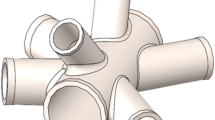Abstract
There are many drawbacks of traditional mold manufacturing technology, especially for dies used on large-scale hydraulic press, such as poor forging penetration, high difficulty of open die-forging process of modules, inferior hardness after heat treatment, high cost, massive waste of invalid forging dies, and so on. Therefore, a new method of mold making is put forward in this paper, which is to do surface welding on casting-steel. The FEM simulation experiments were done to establish a simplified finite element model of the surface welding mold based on JXZG casting-steel. Then, the thermal cycle curve method was used to simulate the surface welding and tempering process. Meanwhile, the temperature field and residual stress field under different welding thickness were analyzed. The finite element modal of landing gear used in a large civil aircraft was established, and then elastic-plastic finite element method was utilized to simulate the forming process of billet and to analyze the temperature field and residual stress distribution of different time. The results demonstrated that FEM could simulate the actual process of surface welding on casting-steel effectively. The equivalent stress close to welding line decreased when the welding thickness inclined, and then it leveled out when the welding thickness was 15 mm; on contrary, the equivalent stress far from welding line increased when the welding thickness declined and the impact of weld pass on casting-steel matrix enlarged which increased the possibility of defects when the casting-steel was used. In sum, when the impact of welding thickness and the cost of mold making are taken into consideration, 16 mm was chosen as the optimal surface welding thickness under given working conditions of landing gear.
Similar content being viewed by others
References
Zhou J, LU S, Quan GZ A method of dual metal layer manufacturing mold based on casting-steel substrate: China,ZL200910104604. X[P]. 2011-01-12
Trethewey KR, Roberget DR (1995) Corrosion management in the twenty-first century [J]. Br Corros J 3:192–197
Aoh J, Jeng Y, Chu E (1999) On the wear behavior of surface clad layers under high temperature [J]. Wear 225/229:1114–1122
Aoh J, Chen JC (2001) On the wear characteristics of cobalt-base hardfacing layer after thermal fatigue and oxidation [J]. Wear 250:611–620
Kim HJ, Kim YJ (1999) Wear and corrosion resistance of PTA weld surfaced Ni and Co base alloy layers [J]. Surf Eng 6:495–501
Xu BS, Zhu SH (1999) The theory and technology of surface engineering [M]. National Defense Industry Press, Beijing, p 249
Xu BS, Liu SC, LIU XH (1986) Plasma spraying and surfacing [M]. China Railway Publishing House, Beijing, pp 80–81
Chen TZ, Li ZG (1990) Metal welding technology [M]. Machinery Industry Press, Beijing, pp 89–90
Wang J (2004) Surfacing and thermal spraying technology [M]. Chemical Industry Press, Beijing, pp 174–176
Wang XH, Zou ZD, Qu SR (2005) Surface strengthening technique of melting and solidification- thermal spraying and surfacing technology [M]. Chemical Industry Press, Beijing, pp 496–497
Xu BS, Zhu SH, Liu SC (2005) Materials surface engineering [M]. Harbin Institute of Technology Press, Harbin, p 129
Hua P, Sun JS (2005) Influence of finite element software SYSWELD in numerical simulation [J]. Shandong Mach 1:10–12
Yang CD, Zhang H, Zhong J (2014) The effect of DSAW on preheating temperature in welding thick plate of high-strength low-alloy steel [J]. Int J Adv Manuf Technol 71(1–4):421–428
Ma QF, Fang RS (2005) The manual of thermophysical properties [M]. Agricultural Machinery Press, Beijing, pp 496–497
Hua Z, Guo GW (1991) The thermal physical properties of engineering alloys [M]. Metallurgical Industry Press, Beijing, pp 52–53
Deng DE, Kiyoshima S (2010) Numerical simulation of welding residual stresses in a multi-pass butt-welded joint of austenitic stainless steel using variable length heat source [J]. Acta Metall Sin 46(2):195–200
Fratini L, Pasta S (2012) Residual stresses in friction stir welded parts of complex geometry [J]. Int J Adv Manuf Technol 59(5–8):547–557
Deplus K, Simar A, Van Haver W (2011) Residual stresses in aluminum alloy friction stir welds [J]. Int J Adv Manuf Technol 56(5–8):493–504
Khalilpourazary S, Dadvand A, Azdast T (2011) Design and manufacturing of a straight bevel gear in hot precision forging process using finite volume method and CAD/CAE technology [J]. Int J Adv Manuf Technol 56(1–4):87–95
Author information
Authors and Affiliations
Corresponding author
Rights and permissions
About this article
Cite this article
Lu, S., Zhou, J. & Zhang, J. Optimization of welding thickness on casting-steel surface for production of forging die. Int J Adv Manuf Technol 76, 1411–1419 (2015). https://doi.org/10.1007/s00170-014-6371-9
Received:
Accepted:
Published:
Issue Date:
DOI: https://doi.org/10.1007/s00170-014-6371-9




